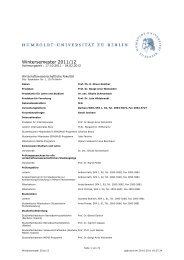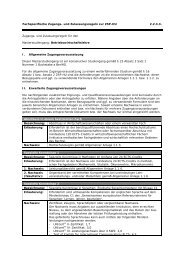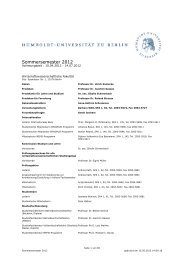Measuring the Effects of a Shock to Monetary Policy - Humboldt ...
Measuring the Effects of a Shock to Monetary Policy - Humboldt ...
Measuring the Effects of a Shock to Monetary Policy - Humboldt ...
Create successful ePaper yourself
Turn your PDF publications into a flip-book with our unique Google optimized e-Paper software.
12 Bayesian FAVARs with Agnostic Identification<br />
among o<strong>the</strong>rs). In <strong>the</strong> next subsections I am first going <strong>to</strong> explain DFMs on which <strong>the</strong><br />
FAVAR methodology grounds. Then I explain <strong>the</strong> FAVAR and <strong>the</strong> required identification<br />
assumptions in order <strong>to</strong> identify <strong>the</strong> fac<strong>to</strong>rs and fac<strong>to</strong>r loading separately. The last sub-<br />
section elaborates on <strong>the</strong> estimation procedures and in particular on <strong>the</strong> likelihood-based<br />
joint estimation.<br />
The classical (static) fac<strong>to</strong>r model applied only <strong>to</strong> cross-sectional data, was first set in<br />
a dynamic setting and introduced <strong>to</strong> economics by <strong>the</strong> seminal work <strong>of</strong> Sargent and Sims<br />
[1977] and Geweke [1977]. Sargent and Sims [1977] applied DFM <strong>to</strong> a low dimensional set<br />
<strong>of</strong> macroeconomic variables in order <strong>to</strong> explain <strong>the</strong> mutual comovements. The dynamic<br />
fac<strong>to</strong>rs parsimoniously summarize <strong>the</strong> dynamics and information <strong>of</strong> a large panel <strong>of</strong> data.<br />
Due <strong>to</strong> <strong>the</strong> small dimensionality <strong>of</strong> <strong>the</strong> data <strong>the</strong> estimation could be accomplished by<br />
maximum likelihood estimation methods (MLE). The MLE will soon arrive at its limits<br />
with increasing number <strong>of</strong> time series. Quah and Sargent [1993] apply <strong>the</strong> EM algorithm<br />
for a set <strong>of</strong> 60 variables which is <strong>the</strong> biggest application considered in a MLE framework.<br />
Due <strong>to</strong> <strong>the</strong> complicated nature <strong>of</strong> <strong>the</strong> shape <strong>of</strong> <strong>the</strong> likelihood in a high dimensional case<br />
it becomes soon infeasible <strong>to</strong> apply ML methods. S<strong>to</strong>ck and Watson [1998,2001] show<br />
that fac<strong>to</strong>r 14 extracted from eight 15 macroeconomic variables, improve <strong>the</strong> forecasting ac-<br />
curacy <strong>of</strong> inflation. Their results outperform <strong>the</strong> standard AR approach but only in a<br />
supportive manner for <strong>the</strong> real variables except for employment. Since <strong>the</strong>n DFMs have<br />
gained an increasing attention in <strong>the</strong> academic world <strong>of</strong> empirical macroeconomics and<br />
seem <strong>to</strong> become an important alternative <strong>to</strong> <strong>the</strong> VAR, which is still <strong>the</strong> ”workhorse” in<br />
empirical macroeconomics and most widely applied.<br />
Important extensions and advances have been achieved especially w.r.t. <strong>the</strong> estimation<br />
14 The authors sometimes refer <strong>to</strong> <strong>the</strong> fac<strong>to</strong>rs as diffusion indexes that summarize <strong>the</strong> inherent risk <strong>of</strong><br />
<strong>the</strong> variables considered<br />
15 In <strong>the</strong>ir first paper <strong>the</strong> consider four variables and extend <strong>the</strong>re data and variables in S<strong>to</strong>ck and<br />
Watson [2001]




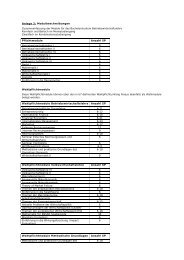

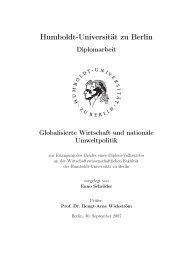
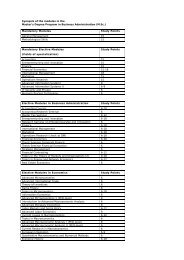
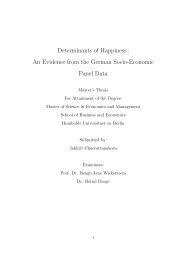
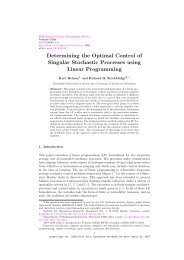
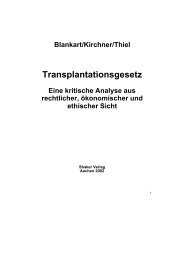
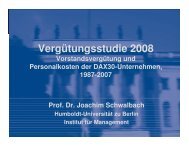

![[Text eingeben] [Text eingeben] Lebenslauf Anna-Maria Schneider](https://img.yumpu.com/16300391/1/184x260/text-eingeben-text-eingeben-lebenslauf-anna-maria-schneider.jpg?quality=85)

